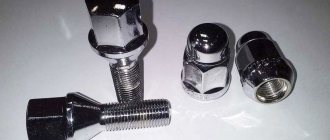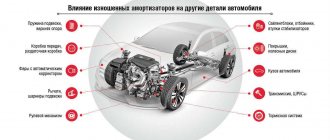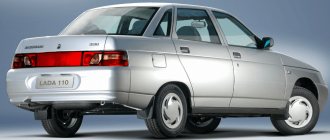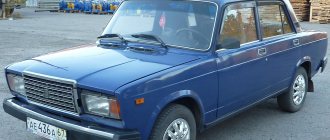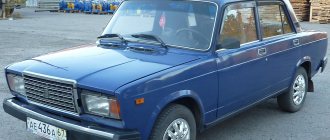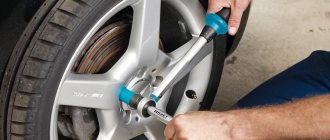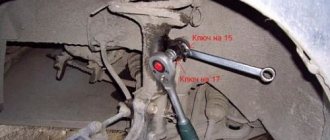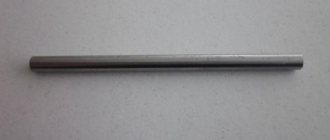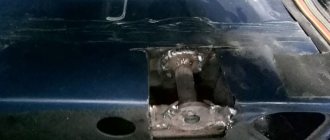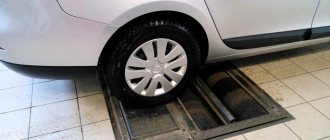The other day I replaced the rear shock absorbers, since until recently there were factory ones that practically did not work anymore. The car has traveled 90,563 kilometers with its family, of which 40,147 km over 8 years, and the remaining 50,416 over the last 2 years after I bought this car.
Instead of the factory ones, I decided to take VAZ 2121 shock absorbers, the seller said that they are a little stiffer than their relatives, and many people install these in place of their relatives. They say that these shock absorbers, unlike the classic ones, work in both directions.
I took a pair of shock absorbers (550 rubles apiece).
One of the shock absorbers
Inside each box there is a small instruction with warranty conditions, information about manufacturers, addresses, etc.
Instructions
I started replacing it on a day off from school. Having a pit in the garage helps a lot with self-repair of the car.
I drove the car into the pit and immediately jumped into the pit to assess the upcoming repairs, the necessary tools and, at the same time, wet all the connections with a “liquid wrench.”
The condition of the old shock absorbers and rubber bushings left much to be desired...
Rear right shock absorber. The plastic casing on the shock absorber rod melted after contact with the muffler pipe - a consequence of the catalyst catching an uneven surface, which displaced the pipe.
The rubber of the bushings is tired...
Rear left shock absorber
Bottom eye with bushings on the right:
Also half-squeezed burst rubber
And on the left is the same story:
Left shock absorber
Removal required two 19mm wrenches. It is advisable to have one of the two or a third 19mm wrench, but a short one - it will be convenient to unscrew the top nut on the shock absorbers, since there is not much space there to swing large wrenches.
First, he tore all the nuts out of place, then began to unscrew everything. First I took out the left shock absorber and immediately installed a new one, as it turned out, I was in a bit of a hurry.
I took off the right one. This is what he looked like:
Rod casing
Hole in the casing
Apparently the muffler pipe heated the metal ring on which the casing sits, and the latter warped and broke.
Rubber bushings of the old and new shock absorber:
For comparison. On the left is a 10 year old shock absorber
And this is a small metal bushing that was inside the lower eye of the shock absorber and which I conveniently forgot about when I installed the new shock absorber on the left, fortunately I did not tighten all the bolts and nuts. The bushing is not broken, just a little rusty, I decided not to change them.
I removed the rust on a machine, smeared the bushings with lithol and installed them in a new shock absorber.
I inserted a bushing into the left shock absorber and put it back, having previously lubricated the pin on top and the bolt on the bottom where the shock absorber is attached.
The left shock absorber is in place.
And I also installed a new shock absorber on the right (I forgot to take a photo).
Both shock absorbers are in place.
Feels like it. A completely different car! The rear of the car has not become stiffer, as some people write, but has become elastic, the car does not wobble after passing “waves” of asphalt on the highway, it immediately returns to its original position. When cornering, the car does not roll heavily, especially when passing roundabouts. Now I'm thinking about replacing the front shock absorbers with Niv ones.
replacing the front suspension shock absorber on a VAZ 2107
The shock absorber on a VAZ 2107 should be replaced if there is fluid leakage from it or loss of the ability to dampen vibrations, deformation of the rod and destruction of the silent blocks.
Shock absorbers on a VAZ 2107 car should be replaced in pairs, even if one of them is working. Front suspension shock absorber mounting parts for VAZ 2107
1 — shock absorber bracket (2101-2904170); 2 — bolt M10X1.25x50 (11343830); 3 – silent block (rubber-metal hinge) of the shock absorber (2101-2905448); 4 — shock absorber (2101-2905402-05); 5 — spring washer (10516870); 6 — nut M10x1.25 (12164721); 7 — washer (2101-2905455-01); 8 — bushing (2101-2905542-20); 9 — shock absorber cushion (2101-2905450); 10 — spring washer (10516870); 11 — nut M10x1.25 (12164721)
Removing the front suspension shock absorber from a VAZ 2107 car
1. We install the VAZ 2107 car on an inspection hole or overpass (see “Preparation of the VAZ 2107 car for maintenance and repair”).
2. Through the technological hole in the mudguard of the VAZ 2107 car, use a 17 mm wrench to unscrew the nut of the upper shock absorber mounting, holding the rod from turning with a 6 mm wrench.
3. Remove the spring washer, the cushion washer and the upper shock absorber mounting pad from the shock absorber rod.
4. Using a 13 mm socket wrench, unscrew the two nuts securing the shock absorber bracket to the lower arm of the front suspension.
5. We take out the shock absorber down through the hole in the lever.
6. Remove the lower cushion from the shock absorber rod.
7. Using a 17 mm socket wrench, unscrew the nut of the bolt securing the shock absorber to the bracket, holding the bolt from turning with a wrench of the same size.
8. Having removed the bolt, disconnect the shock absorber from the bracket.
When the shock absorber pads wear out, replace them.
Installing a front suspension shock absorber on a VAZ 2107 car
1. Installation of the shock absorber on a VAZ 2107 car is performed in the reverse order.
2. After installing the shock absorber bracket on the lower arm, put the lower cushion on the rod and extend it completely. From the engine compartment side, install bushings and washers on the rod and tighten the nut of the upper shock absorber mounting.
Similarly, on a VAZ 2107 car we replace the second shock absorber.
Source
Shock absorbers VAZ 2107
Despite the fact that the VAZ “Seven” is presented as a luxury version of the VAZ 2105, the design of the front and rear suspensions is no different from other classic models. This also applies to shock absorbers, which not all owners are satisfied with their performance.
Purpose and design
The main function that shock absorbers perform in a car’s suspension is to dampen vibrations and shocks that affect the body when driving over uneven surfaces. This part ensures reliable contact of the wheels with the road surface and maintains vehicle controllability regardless of the condition of the road surface. Structurally, the shock absorber consists of two elements - a piston and a cylinder. Depending on the type of damping device, chambers with oil and air or oil and gas are located inside the cylinder. The gas or oil medium exerts resistance during the movement of the piston, converting vibrations into thermal energy.
Design of shock absorbers of the front and rear suspensions: 1 - lower eye; 2 — compression valve body; 3 — compression valve discs; 4 — throttle disk of the compression valve; 5 — compression valve spring; 6 — compression valve cage; 7 — compression valve plate; 8 — recoil valve nut; 9 — recoil valve spring; 10 — shock absorber piston; 11 — recoil valve plate; 12 — recoil valve discs; 13 — piston ring; 14 — recoil valve nut washer; 15 — throttle disk of the recoil valve; 16 — bypass valve plate; 17 — bypass valve spring; 18 — restrictive plate; 19 - reservoir; 20 - rod; 21 - cylinder; 22 — casing; 23 — rod guide bushing; 24 — sealing ring of the tank; 25 — rod seal race; 26 — rod seal; 27 — gasket of the rod protective ring; 28 — rod protective ring; 29 — tank nut; 30 — upper shock absorber eye; 31 — nut securing the upper end of the front suspension shock absorber; 32 — spring washer; 33 — shock absorber mounting pad washer; 34 — pillows; 35 — spacer sleeve; 36 — front suspension shock absorber casing; 37 — rod buffer; 38 - rubber-metal hinge
What are there
There are several types of shock absorbers:
- oil;
- gas;
- gas-oil with constant hardness;
- gas-oil with variable hardness.
Each option has its own advantages and disadvantages.
On the VAZ 2107, oil twin-pipe shock absorbers are installed at the front and rear.
Table: dimensions of the rear original dampers of the “seven”
| vendor code | Rod diameter, mm | Case diameter, mm | Body height (excluding stem), mm | Rod stroke, mm |
| 21012915402 | 16 | 42 | 310 | 182 |
Oily
The working medium in oil damping elements is oil. The advantage of such products comes down to a simple and reliable design. This type of damper can operate without problems for several years without affecting the vehicle's performance. The downside is the slow response. The fact is that when driving at high speeds, the damper simply does not have time to absorb irregularities and return to its original position, as a result of which the car begins to rock. Shock absorbers of this type are recommended for those motorists who drive at speeds no higher than 90 km/h.
The working medium in oil shock absorbers is oil
Find out how to change the oil on a VAZ 2107 yourself: https://bumper.guru/klassicheskie-modeli-vaz/dvigatel/zamena-masla-v-dvigatele-vaz-2107.html
Gas
Gas-type products are the toughest. The design, compared to oil damping elements, has two chambers: oil and gas, which uses compressed gas (nitrogen) under a pressure of 12–30 atm. Such shock absorbers are used in racing cars and on some SUVs.
There are no pure gas shock absorbers, since oil is used to lubricate the pistons and seals.
Gas-oil with constant hardness
The design of this type of damper is two-pipe, i.e. there is an inner pipe in the outer pipe. The product has two pistons with valves and contains gas under a pressure of 4–8 atm. and oil. When the shock absorber rod is compressed, part of the oil remains in the inner tube and works like an oil damper, and part goes into the outer tube, causing the gas to be compressed. When compressed, the gas pushes out the oil, returning it to the inner tube. Due to this work, smoothness is ensured, leading to smoothing out shocks. Such shock absorbers are less rigid compared to gas ones, but not as soft as oil ones.
Gas-oil shock absorbers are more rigid due to the use of gas together with oil
Gas-oil with variable hardness
On Zhiguli cars, dampers with variable stiffness are practically not used, which is due to the high cost of such products. Structurally, such elements have an electromagnetic valve that automatically adapts to the operating mode of the vehicle. During the adjustment process, the amount of gas in the main damper tube changes, resulting in a change in the rigidity of the mechanism.
Video: types of shock absorbers and their differences
Where are they located?
The shock absorbers of the rear suspension of the “seven” are installed near the wheels. The upper part of the damper is attached to the car body with a pin, and the lower part is fixed to the rear axle by means of a bracket.
Design of the rear suspension of the VAZ 2107: 1 - spacer sleeve; 2 — rubber bushing; 3 — lower longitudinal rod; 4 — lower insulating gasket of the spring; 5 — lower spring support cup; 6 — suspension compression stroke buffer; 7 — bolt for fastening the upper longitudinal rod; 8 — bracket for fastening the upper longitudinal rod; 9 — suspension spring; 10 — upper spring cup; 11 — upper insulating gasket of the spring; 12 — spring support cup; 13 — rod of the rear brake pressure regulator drive lever; 14 — rubber bushing of the shock absorber eye; 15 — shock absorber mounting bracket; 16 — additional buffer for suspension compression travel; 17 — upper longitudinal rod; 18 — bracket for fastening the lower longitudinal rod; 19 — bracket for fastening the transverse rod to the body; 20 — rear brake pressure regulator; 21 — shock absorber; 22 — transverse rod; 23 — pressure regulator drive lever; 24 — holder of the lever support sleeve; 25 — lever support sleeve; 26 — washers; 27 — spacer sleeve
More about the rear suspension design: https://bumper.guru/klassicheskie-modeli-vaz/hodovaya-chast/zadnyaya-podveska-vaz-2107.html
Replacing front shock absorbers on VAZ 2101-VAZ 2107
Welcome! Car shock absorbers - how the car will behave in the future on smooth and uneven roads depends only on them. Over time, car shock absorbers deteriorate and therefore need to be replaced. In this article, we have written detailed instructions on how you can replace the front shock absorbers on cars of the “Classic” family.
Note! To perform the replacement, you will need the following tools: First, be sure to stock up on a set of basic wrenches and new shock absorbers. And also, if you have one, take with you a special key for removing shock absorbers; for clarity, it is shown in the figure below:
Question? Which shock absorbers do you prefer: “Gas-oil” shock absorbers or conventional “Hydraulic” ones? (Write your answer in the comments)
Summary:
When do you need to change front shock absorbers? They must be replaced if:
- Loss of its properties, that is, loss of efficiency in damping vibrations.
- And it must also be replaced with a new one if it starts to leak and as a result becomes oily.
Note! To properly verify whether the shock absorbers are working or not, you can read the article entitled: “Checking shock absorbers for performance”!
How to replace front shock absorbers on a VAZ 2101-VAZ 2107?
Note! Both shock absorbers are replaced in the same way, so we will show their replacement only using the example of one shock absorber!
Removal: 1) First drive the car into the inspection hole, or hang it up using a lift.
2) Now open the hood and pick up the special key (If you don’t have it, then use small pliers). Next, place a special wrench on the shock absorber rod, which is indicated by the number “1” in the photo, thereby reducing the likelihood of the rod turning along the axis.
Immediately after this, use a wrench labeled “2” to unscrew and then remove the nut, after the nut, remove the spring washer, as well as the cushion washer and the upper shock absorber mounting cushion itself.
Replacing shock absorbers on a VAZ 2107 car
The suspension on VAZ cars of the classic family has certain features and differences from the suspensions installed on modern car models. The design of the suspension on Zhiguli cars has an archaic and heavy design, which inevitably affects the quality characteristics of the stability and controllability of the car. In this connection, there are certain nuances associated with the installation and adjustment of shock absorbers on rear-wheel drive VAZ models.
Due to the design features, the front shock absorber mount on the VAZ 2107-2101 “Classic” is a separate part. The rear dampers on the classics and their fastenings are completely installed on the dependent axle, which negatively affects the stability of the car. That is why it is extremely important to pay attention to the adjustment of shock absorbers and subject the suspension to timely repairs and maintenance.
How to properly inspect a suspension
Despite the fact that the dependent rear suspension on the VAZ 2107 is particularly wear-resistant, drivers should still closely monitor its condition (especially if you often drive on bumpy roads). To do this, you just need to drive the car onto a lift or use a pit. All damage according to the site mashinaa.ru and malfunctions will immediately catch your eye.
Particular attention should be paid to the following points:
- wear of rubber elements;
- gaps between car parts;
- traces of oil leaks on telescopic shock absorbers;
- the rubber bushings of the rods must be motionless, that is, have no play;
- If the bushings are very loose, the rods must also be replaced.
Since the rear suspension axle device is supported only by rods and holes located on the bottom of the shock absorbers, the maneuverability and behavior of the car depend on its condition. If you replace the necessary elements in a timely manner, your VAZ 2107 car will serve you faithfully for many years.
Purpose and design of shock absorbers VAZ 2107
The main purpose of shock absorbers in a car is to smooth out and absorb vibrations (shocks) from the road surface and prevent the transfer of mechanical energy to the car body. Dampers are attached on one side to the power parts of the body, and on the other to the suspension parts (levers, bridge).
The suspension arms are constantly subject to vertical vibrations, ensuring the stability of the car, so shock absorbers in this “bundle” play an important role. When shock-absorbing parts in a car wear out, part of the load is transferred to the suspension and body elements, which greatly affects the service life of the suspension.
The racks are a tubular structure of hydraulic or gas type. Smoothing of vibrations from the road surface in such shock-absorbing struts occurs due to the oil or gas located inside. The rigidity of the struts and the progress of work depend on the speed of movement of the rod in the structure, the viscosity of the oil (gas density) and the settings of the bypass valves.
Shock absorber malfunctions
There are a number of indicators by which you can determine that the shock-absorbing elements of your car have become unusable and will need to be replaced in the near future. Otherwise, difficulties will arise in driving the car, and the braking distance will increase.
Oil leaks
The simplest sign indicating damper wear is the appearance of oil smudges on the body, which can be determined by visual inspection.
A shock absorber leak indicates the need to replace the element.
If such signs occur, it is recommended to verify that the element in question is faulty by sharply pressing the rear fender with your hands and releasing it. If the part is working properly, the suspension will slowly sag and return to its original position. When the shock absorber is not functioning properly, the rear of the vehicle will bounce on the spring, quickly returning to its original position.
Video: identifying a faulty damper without removing it from the car
Knock and squeak when driving
The most common cause of knocking in shock absorbers is fluid leakage. If there are no signs of leakage, it is necessary to carry out the test described above with the machine rocking. The knocking noise may also be the cause of damper wear. If a part has traveled more than 50 thousand km, then you should think about replacing it. Common causes of knocking also include air entering the outer cylinder of the damper due to an oil leak. You can try to fix the problem by bleeding it. If, while the car is moving, a squeak is heard from the rear suspension, then the cause of the malfunction may be worn rubber bushings of the upper and lower shock absorber lugs.
Uneven tire wear
Problems with shock absorbers can also be noticed by uneven tire wear, which significantly reduces their service life. This is explained by the fact that while driving with a faulty damper, the wheels often come off the road surface and cling to it again. As a result of this process, the rubber wears unevenly. In addition, you can notice wear in the form of patches, which is due to imbalance of the wheels. Therefore, the tire tread condition must be periodically monitored.
If your tires wear unevenly, one of the likely causes is problems with the shock absorbers.
Sluggish braking
If the shock-absorbing elements are faulty or there are problems in their operation, the contact of the wheels with the road surface worsens. This leads to short-term tire slippage, reduced braking efficiency and increased brake pedal response time, which in some cases can lead to accidents.
Plunging and pulling of the car to the sides when braking
Malfunction of the shock absorber valves, as well as wear of the seals inside the product, can cause noticeable swaying of the body when you slightly press the brake pedal or move the steering wheel. A clear sign of a malfunction is strong body roll when cornering, which also often requires steering. A malfunction of the shock-absorbing elements is also indicated by dives of the front or rear of the car during sudden braking, i.e., when the front end drops strongly and the rear lifts up. The vehicle may pull to the side, for example, if the rear axle is not installed level. This is possible when the longitudinal rods break and subsequent poor-quality repairs occur.
Car instability on the road
If the “seven” behaves unstably while moving and is thrown to the sides, then there may be many reasons for this behavior. It is necessary to inspect the condition of the elements of both the front and rear suspension, as well as the reliability of their fastening. Regarding the rear of the car, it is worth noting that attention should be paid to the condition of the shock absorbers, rear axle links, and rubber seals.
Shock absorber ripped out
Sometimes VAZ 2107 car owners encounter such a problem when the mounting rings of the rear suspension shock absorbers break off. This problem arises when installing spacers under original springs or springs from a VAZ 2102, VAZ 2104 in order to increase ground clearance. However, with such changes in length, the standard shock absorbers are not enough and the mounting eyes tear off after a while.
When installing high springs in the rear suspension and using original shock absorbers, the lugs break
To prevent this from happening, it is necessary to install a special bracket, which reduces the shock absorber stroke.
To prevent shock absorber lugs from being torn off when installing high springs, special brackets are used that reduce the damper travel
There is another option - to weld an additional “ear” below the old damper, which will also reduce the stroke and prevent failure of the suspension element in question.
Video: why the rear shock absorbers pull out
How to choose shock absorbers
Choosing shock absorbers is not an easy task, since it is necessary to take into account a number of important factors that will subsequently affect the handling and service life of the car’s suspension. First of all, you need to pay attention to the following points:
- type of racks (gas or oil);
- length;
- permissible loads;
- compatibility with specific brands and models of cars.
The type of struts affects the stiffness of the suspension and its service life. Thus, gas struts are better suited for those drivers who prefer a more or less sporty ride and the most informative and “understandable” steering wheel. Installing oil-filled shock absorbers is more preferable for quiet motorists who use the car to perform everyday tasks.
Oil dampers are softer than gas dampers and provide comfort for the driver and passengers. Gas models are quite rigid, but this is a kind of payment for greater stability of the car on the road.
The length of the struts affects the vehicle's ground clearance. Installation of tuning models of struts with a lowering from -30 to -70 mm has a positive effect on the handling and stability of the car, as the center of gravity is reduced. There are models on the market with both factory length parameters and modified ones.
The permissible load indicator indicates how much the car can be loaded without compromising the condition of the suspension. As a rule, in expensive gas models this indicator is higher, which has a positive effect on the overall condition of the suspension and the service life of its parts.
Replacing front and rear shock absorbers
Self-repair and replacement of shock-absorbing parts in a car suspension is not as complicated a procedure as it might seem at first glance. However, work related to parts that affect the vehicle's handling must be carried out with the utmost care.
Tools, materials and components
To carry out work on replacing shock absorbers on classic VAZs, you will need a certain list of tools. Most at least slightly advanced drivers have these tools.
- a set of open-end wrenches and/or socket heads;
- adjustable wrench;
- strong large slotted screwdriver;
- pliers;
- wheel wrench;
- graphite lubricant;
- WD-40 or other similar “liquid key”;
- jack.
- drill and a set of drills for it;
- grinder (angle grinder) and cutting wheels for it;
- gas-burner;
- knife;
- gas key;
- hammer.
Removing shock absorbers
The process of removing the suspension struts does not take much time and boils down to unscrewing the shock absorber mounting bolts and pulling the part out of the retaining grooves. The main problem during removal, which most drivers of classic VAZ models encounter, is the difficulty of unscrewing the nut of the shock absorber mounting bolt.
Features of repair of shock absorber mounts
The designers of VAZ cars of the classic family did not provide for the possibility of serious loads when designing the design of the upper mounts for the rear dampers. Therefore, many car enthusiasts encounter problems when installing rear struts on the upper mounts.
The upper mounts are metal studs secured to the body cross member at the rear of the car. Over time, metal fatigue appears at the fastening points due to the constant loads from the operation of the dampers, so the metal studs often crack and break off, or the fastenings themselves fail.
To solve problems with the upper fastenings, owners of classic Lada cars often resort to replacing the studs with new ones. To do this, holes are cut out at the locations of the fasteners using a grinder and the old studs are removed.
After that, new steel pins and washers are installed in the mounting holes, and the fastening points are securely welded with a welding machine.
You can safely install new shock absorbers on new mounts and not worry about the reliability of the mounts.
Source
Frequent malfunctions
Knocks
Knocks in the rear suspension can be of different types and the reasons for their occurrence are also different:
- knocking sound when starting. The malfunction occurs when one of the rear axle reaction rods or the brackets that hold them break. To solve the problem, it is necessary to inspect the suspension, identify the damaged rod and replace it;
- knocking noises while driving. Broken silent blocks of jet rods can knock. Over time, the metal bushing simply begins to dangle in the rubber, and the bridge “walks,” which leads to the appearance of extraneous sounds. The malfunction is treated by replacing the rubber bushings of the rear axle rods;
- knocking noise when the suspension is compressed too hard. This happens when the bump stop is damaged, causing the suspension to “break through.” Therefore, it is necessary to inspect the buffer elements and replace the failed ones.
Breaks through the suspension
Such a concept as “breakdown” occurs when the suspension does not cope with its function. There may be several reasons for this:
- rear axle overload. The suspension can often “punch” due to an overloaded rear axle, for example, if the car is heavily loaded. In this case, you need to unload the rear axle;
- breakage or settling of the spring. Despite the fact that the springs are made of durable steel, they still sag over time, especially with frequent transportation of goods. The way out of the situation is to install new or stiffer springs;
- failure of shock absorbers. If the shock absorbers are unable to dampen vibrations, then full operation of the suspension is impossible. The shock-absorbing elements will need to be replaced.
The car is pulled to the side
Sometimes with the suspension of the VAZ “Seven” there are such nuances when the car pulls to the side. Let's list the reasons why this can happen:
- spring breakage or settling. Due to a damaged spring, the car will stand unevenly on the road, which may cause it to move to one side. The spring will need to be replaced;
Damage to the spring may cause the vehicle to pull to one side. - displacement of the rear axle due to wear of the silent blocks of the reaction rods. The appearance of free play in the suspension elements leads to unstable behavior of the car on the road, which indicates the need to replace rubber-metal components.
There can be many more reasons why a car pulls to the side. In addition, a malfunction is possible not only in the suspension, but also in other components, for example, with a flat tire.
Other sounds
Extraneous noises and sounds can come not only from faulty suspension elements, but also from the chassis, which is not always easy to determine with insufficient experience. While driving, a hum from the rear axle gearbox itself may be heard from the rear of the car, which requires adjustment or replacement.
In addition to the gearbox, the axle bearings may hum as a result of wear or a small amount of lubricant. When the springs sag, the wheels may touch the plastic wheel arch liners when cornering, if they are installed. They can also simply loosen the wheel bolts if they are loosely tightened, which will lead to extraneous noise.
Therefore, each specific case needs to be dealt with separately, where and at what moment this or that sound comes from. Only in this case will it be possible to more accurately diagnose the malfunction.
You might be interested in reading:
- Steering gearbox VAZ 2107 - design, replacement and repair Where is the steering gearbox located? It is located in the engine compartment and immediately under the vacuum brake booster (Indicated by a blue arrow), for…
- VAZ 2107 stove - design, repair, modifications The VAZ 2107 stove creates and maintains a comfortable air temperature in the cabin and prevents the windows from fogging in cold and humid weather...
- Cooling system of the VAZ 2107 - diagram, device Movement is life, but movement is heat. Try rubbing your palms together and see for yourself...
- Starter for VAZ 2114 its design and repair Principle of operation After turning the ignition key, current is supplied from the battery to the relay. The Bendix drive is connected to the flywheel. The starter starts the engine...
- VAZ 2115 fuel system - diagram, design and repair Fuel system diagram Fuel supply system with distributed injection: 1 – fitting for monitoring fuel pressure; 2 – fuel rail;…
